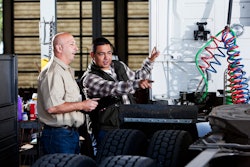When one of your trucks is involved in a crash event, it’s a stressful situation. There’s a lot to manage between helping your driver and working with the other parties involved.
The first thing that sets people on edge is the number of players involved. The police? Sure. But that’s just the start. Remember it can also include governmental departments for the environment, plus insurance stakeholders, lawyers, paralegals, the media, bystanders, residents and more. Yikes.
Now consider two things: your driver will have to deal with any number of these folks right in the middle of having one of the worst days of his or her career (and probably while being in shock); and the next thing these stakeholders are going to do is call you. Will you know what to say and what resources to mobilize? I caught up with John Farquhar from Summit Risk Solutions and Rick Morgan of Links Consulting to discuss this issue and what fleets should be doing when a driver is involved in a collision.
Take care of your drivers
When one of your drivers is involved in a crash -- after checking to see if they’re physically and mentally alright of course – give them support. Lots of it. They’re going to need it and you must help them understand their rights and responsibilities.
- The police are going to talk to them, and your driver needs to know their rights (including what they should and should not be saying)
- Their cellphone may be confiscated right away as evidence—the vast amount of information that can be gotten from the forensic data analysis of a phone has made cellphone confiscation an almost standard practice
- Were they carrying hazmat? First responders will be asking them for details in order to manage the situation
- Your driver will probably want to contact their family (which will be difficult when their phone has been taken)
From policy to plan
When the police, government officials and insurance partners call you, your team will need to be ready. And the press? If it’s a big event, they're going to write a story about you, whether you speak to them or not. Know what you want to say to them when they call so you at least have some input in how you are portrayed in the media. If the accident is especially severe, with loss of life, or significant property damage, consider hiring a PR person for counsel.
All of this requires more than just having a broad-strokes policy; it requires serious thinking about who will play what role on your team, what their responsibilities will be and how you want to control the situation. It requires a plan. When building a crash response plan, here are five elements to consider:
- Have a “serious event” team at your company More than a vague acknowledgment that managing the crisis should be the responsibility of 'management,' have a dedicated set of people with specific responsibilities. For example, driver outreach—there should be one person who will be the driver’s first point of contact when they need help, and this person should be responsible for checking on the driver’s welfare, notifying loved ones, and generally walking them through the process. Don't bounce the driver around by telling them to call this person for one issue and that person for another. They've been through enough, so make it easy for them. Another team member should be responsible for contacting insurance and legal stakeholders, and have a point person for dealing with the media. Smaller fleets may only have one or two leaders in the company available for these roles, but it's still critical that there is a clear understanding of who is doing what.
- Don't leave your driver to figure it out themselves Given the enormous stress they will be under; even well-prepared drivers will have a tough time remembering everything they need to do if they are in a crash (and that is assuming they aren't injured). So, make sure they have simple, easy-to-follow protocols and just one number to call to get through to the serious event team at your company. What's more, know how you will get a replacement phone to your driver if (or when) theirs is confiscated for evidence.
- Know what to say and what will be said Journalists will do whatever they can to find out about the situation and the people involved—and they will construct a story out of whatever they find. You can decide whether you want to give them information or not, but just know that they will write one either way. Make sure you know ahead of time what you want said, who is going to say it, and how (phone interview, email, etc.). Have that information scripted and available so the message you want to send is consistent. This also goes for passing information on to the rest of the company. Rather than letting rumors fly, make sure you are the one controlling the information flow to your team.
- Practice Table talk your plan as if you were actually in the situation and you just got the call from a driver. Have the team leader clarify roles, troubleshoot communication and generally get people used to stepping into these roles when needed. Even better, run a drill. Have a driver work with you to put in a call as if they have had a crash event, but lead the rest of your crash team to believe that it is a real event. Afterwards, you'll be able to talk them through what went well and what didn't and give them a taste of the kind of stress they will be under when it happens.
- Use your insurance partners If you're stuck on figuring out what else your plan should have, reach out to your insurer for guidance. Not only do they have experience, but they'll also be invested in making sure your plan is comprehensive (and they'll be thankful you're doing it in the first place).
Remember that a serious event for a fleet is a 'when' rather than an 'if'; getting prepared for it to keep your people and company in control is a must do.











